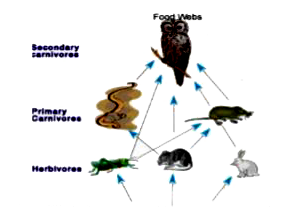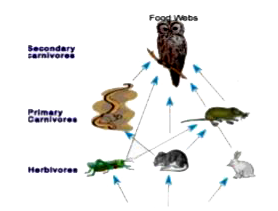In an open ocean, the biomass of primary produceres (microscopic algae) is often lower than the biomass of higher trophic levels (zooplanktons and fish), as illustrated below by an inverted pyramid of biomass. How can there be enough food in an open ocean to suppor the higher trophic levels? 
The microscopic primary producers are a source of food of high quality.
The microscopic primary producers have high rates of growth and reproduction.
The microscopic primary producers are less abundant.
The higher trophic levels are cold-blooded animals which do not require much food.
The correct Answer is:B
In an open ocean, the large numbers of phytoplankton quickly complete their life cycles and sets of new propulation or crops of phytoplankton are formed every few hours or days. Thus, the cumulative energy contents that these generation after generation of phytoplankton trap in course of a year is certainly much more than trapped by only a few generations of of herbivorous fishes in the corresponding time and space.
Topper's Solved these Questions
Similar Questions
[A] : The pyramid of biomass indicates the decrease or the gradual reduction in biomass at each trophic level from base to apex .
[R] : In case of parasites , the pyramid of biomass is inverted .
View SolutionConstruct a pyramid of biomass starting with phytoplankton. Label trophic levels. Is the pyramid upright or inverted? Why?
View Solution
Knowledge Check
In most ecosystems, the biomass of a trophic level is higher than the biomass of its predators, as illustrated below by an upright pyramid of biomass. In the open ocean, however, the biomass of primary producers (microscopic algae) is often lower than the biomass of higher trophic levels (for example, zooplankton and fish), as illustrated below by an inverted pyramid of biomass, in the open ocean, how can there be enough food to support the higher trophic levels?

Remember— The width of the bars indicates the amount of biomass at each trophic level.AThe microscopic primary producers are a source of food of high quality.BThe microscopicprimary producers have high rates of growth and reproduction.CThe microscopic primary producers are very abundant.DThe higher trophic levels are cold-blooded animals which do not require much food.The pyramid of biomass shows a sharp ……………at higher trophic levels.
Adecrease in biomassBincrease in biomassCdecrease in numberDincrease in numberRead the following statement . With respect to the ecological pyramid , mark the correct statements.
a . In most of the ecosystems , pyramids of number , energy and biomass are upright .
b. Producers are generally more in number or biomass than herbivores in an upright pyramid.
c. Herbivores are less in number and biomass than carnivores in an inverted pyramid.
d. Energy content is higher at a lower trophic level than that at a higher trophic level.Ab and d are correctBa , b , and c are correctCa, d and d are correctDAll are correct
Food chains are very important for the survival of most species. When only one element is removed from the food chain it can result in extinction of a species in some cases. The foundation of the food chain consists of primary producers
Primary producers, or autotrophs, can use either solar energy or chemical energy to create complex organic compounds, whereas species at higher trophic levels cannot and so must consume producers or other life that itself consumes producers. Because the sun's light is necessary for photosynthesis, most life could not exist if the sun disappeared. Even so, it has recently been discovered that there are some forms of life, chemotrophs, that appear to gain all their metabolic energy from chemosythesis driven by hydrothermal vents, thus showing that some life may not require solar energy to thrive.

Which of the following limits the number of trophic levels in a food chain?
View SolutionFood chains are very important for the survival of most species. When only one element is removed from the food chain it can result in extinction of a species in some cases. The foundation of the food chain consists of primary producers
Primary producers, or autotrophs, can use either solar energy or chemical energy to create complex organic compounds, whereas species at higher trophic levels cannot and so must consume producers or other life that itself consumes producers. Because the sun's light is necessary for photosynthesis, most life could not exist if the sun disappeared. Even so, it has recently been discovered that there are some forms of life, chemotrophs, that appear to gain all their metabolic energy from chemosythesis driven by hydrothermal vents, thus showing that some life may not require solar energy to thrive.

Mr. X is eating curd/yogurt. For this food intake in a food chain he should be considered as occupying
View SolutionFood chains are very important for the survival of most species. When only one element is removed from the food chain it can result in extinction of a species in some cases. The foundation of the food chain consists of primary producers
Primary producers, or autotrophs, can use either solar energy or chemical energy to create complex organic compounds, whereas species at higher trophic levels cannot and so must consume producers or other life that itself consumes producers. Because the sun's light is necessary for photosynthesis, most life could not exist if the sun disappeared. Even so, it has recently been discovered that there are some forms of life, chemotrophs, that appear to gain all their metabolic energy from chemosythesis driven by hydrothermal vents, thus showing that some life may not require solar energy to thrive.

The decomposers are not included in the food chain. The correct reason for the same is because decomposers:
View SolutionWhich of the given below pyramids represents the variation in biomass at different trophic levels in pond ecosystem?
View SolutionWhich of the following statement/s regarding ecological pyramid is/are wrong?
I. In most ecosystem, all the pyramids, of number, of energy and biomass are upright.
II. Each trophic level has a certain mass of living material at a particular time called as the standing crop.
III. The pyramid of biomass in sea is generally upright because the biomass of fishes far lower that of phytoplankton.
IV. Pyramid of energy is always upright, can never be inverted.
V. Energy at a lower trophic level is always less than at a higher level.
View Solution
